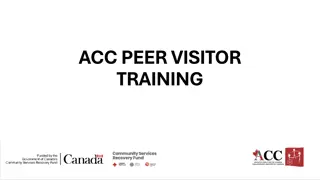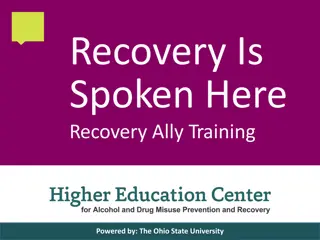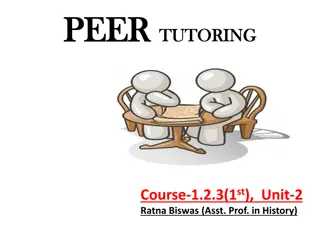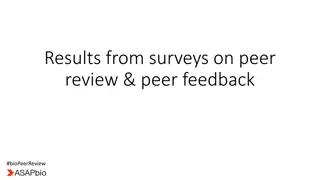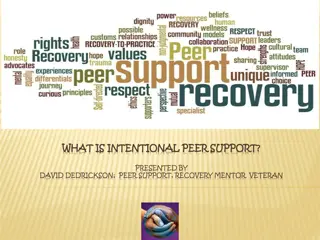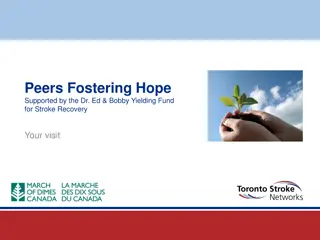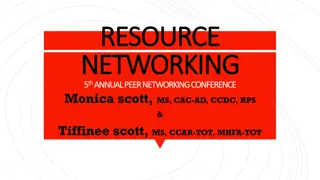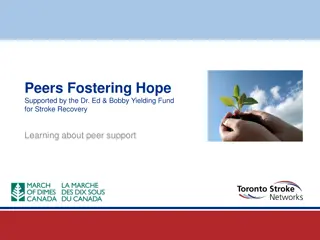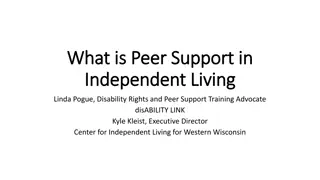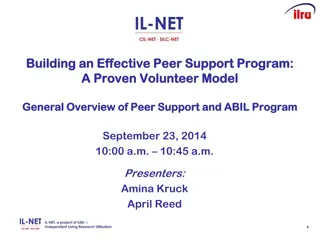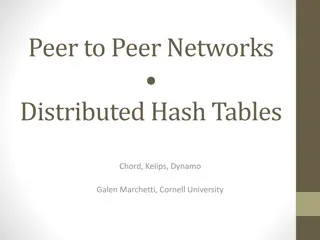Understanding Peer Support and Connectedness in Recovery Context
Explore the concepts of peer support and connectedness in a recovery context through the lens of inclusivity and community belonging. Discover the importance of peer support in mental health recovery, the features that define it according to Yalom, and the benefits it brings. Through shared experiences and support, individuals can find hope, belonging, and strategies for managing their mental health.
Download Presentation

Please find below an Image/Link to download the presentation.
The content on the website is provided AS IS for your information and personal use only. It may not be sold, licensed, or shared on other websites without obtaining consent from the author. Download presentation by click this link. If you encounter any issues during the download, it is possible that the publisher has removed the file from their server.
E N D
Presentation Transcript
Peer Support
Connectedness Think about a time when you were included in a community or group. How did it make you feel? were excluded from a community or group. How did it make you feel?
Peer Support pie chart Divide this pie into pieces to represent what peer support means to you.
Peer Support in a recovery context Recovery focuses on people recovering a quality of life in their community while striving to achieve their full potential. Peer support is rooted in the knowledge that hope is the starting point from which a journey of recovery must begin. Peer support can help to increase feelings of belonging and reduce isolation. Meeting and talking with people with shared experiences helps to identify tips and strategies for managing our mental health, encouraging participants to focus on their strengths and draw on their own experience to help others.
Features of peer support (Yalom)
Features of peer support Factors Universality Definition Feelings of having problems similar to others, not alone. Validates experiences. Members at different stages of development or recovery. Shows that recovery is possible. Guidance or advice provided by group members. Feelings of trust, acceptance and belonging within the group. Opportunity to tell your story/for expression/release strong feelings. Developing social skills learning new ways to talk about feelings, observations and concerns. Opportunity to rise out of oneself and help somebody else, the feeling of usefulness. Receiving feedback from others and experimenting with new ways of relating. Recognition of the basic features of existence through sharing with others. Gain understanding of the impact of upbringing on personality and patterns of relating. Instillation of Hope Imparting Information Group Cohesiveness Catharsis Socialisation Altruism Interpersonal Learning Existential Factors Corrective recapitulation of the primary family group Imitative Behaviour Observing and imitating others. Modelling good behaviours.
Benefits of peer support Meeting with people who speak your language Learning from people who have been where you are Sharing your experiences with others Learning about yourself No judgement Boosting self-esteem/self-worth Social skills Hope and support Sense of humour Cooperation Helping yourself by helping others
Belonging Belonging is a natural human need. It relies on both conformity and individuality. Through belonging we develop new understandings of ourselves and the world around us. Our sense of identity is stronger when we belong.
Belonging Consider the following questions: What does it mean to belong? What is community? In what communities do you have membership?
Belonging vs Fitting in A bit about Connection and Belonging from Brene Brown s book The Gift of Imperfection. One of the major themes in Brene s work revolves around the difference between Belonging versus Fitting In . Often mistaken as synonyms, these two terms have very different meanings, as well as very different impacts on your life. Fitting in is about assessing a situation and becoming who you need to be to be accepted. For example, think of a chameleon. Belonging, on the other hand, doesn t require us to CHANGE who we are. It requires us to BE who we are. Belonging is the innate human desire to have close, caring and intimate relationships with other people and to be part of something larger than us. Because this yearning is so primal, we often try to acquire it by fitting in and by seeking approval. These strategies are not only hollow substitutes for belonging, but often barriers to it. Because true belonging only happens when we present our authentic, imperfect selves to the world, our sense of belonging can never be greater than our own level of self-acceptance; imperfections, flaws and all.
The 5 As 1. Attention 2. Acceptance 3. Appreciation 4. Affection 5. Allowing
The 5 As Attention from others leads to self- respect. Acceptance engenders a sense of being inherently a good person. Appreciation generates a sense of self-worth. Affection makes us feel lovable. Allowing gives us the freedom to pursue our own deepest needs, values, and wishes.
Lived Experience Consider the following questions: What have you learned about yourself and your recovery that could inspire others working on their recovery if you share the information? What types of support have you developed and used? How could you communicate your recovery story to others?


